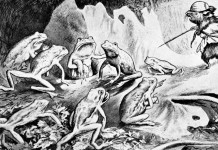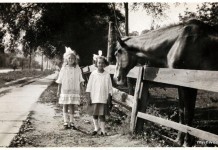 Theories abound as to the origin of the black squirrels commonly seen in Inwood.This we do know. During the Presidency of Teddy Roosevelt 18 black Canadian squirrels were released at the National Zoo. Before long, DC was literally crawling with the little black critters.
Theories abound as to the origin of the black squirrels commonly seen in Inwood.This we do know. During the Presidency of Teddy Roosevelt 18 black Canadian squirrels were released at the National Zoo. Before long, DC was literally crawling with the little black critters.
Richard W. Thorington Jr., a Smithsonian Institution researcher working on a book that includes a history of the District’s black squirrels, said in an interview with the Washington Post, “It shows the spread of a gene within a population. That is evolutionary change before your eyes.”
But the notes kept in the Smithsonian archives are threadbare, stating only, “In 1902, and then again in 1906, the zoo got black squirrels from “the department of crown lands” in Ontario.”
The black squirrels spread to New York within a few short years,
but paybacks are hell. In 1909 New York City Mayor William Jay Gaynor donated eight pairs of the invasive little critters to the City of Vancouver where they today have come to dominate the landscape.
 Genetics play a huge role in the rapid spread of black squirrels to other small pockets of the nation. Scientists believe that in the winter time the black coats allow the black squirrels to retain sunlight and hence warmth much more effectively than their grey cousins.
Genetics play a huge role in the rapid spread of black squirrels to other small pockets of the nation. Scientists believe that in the winter time the black coats allow the black squirrels to retain sunlight and hence warmth much more effectively than their grey cousins.
According to Thorington, “If you can do it with solar heat, you don’t need quite as much metabolic heat,” and, therefore, need less food.”
Another huge black squirrel population resides in Kent, Ohio, home to Kent State University. In 1961, ten black Canadian squirrels were imported to Kent where they quickly took over. But if you can’t beat them, join them. Each year Kent State University holds a Black Squirrel Festival.
Now that the back squirrels have established themselves in Inwood, they are likely here to stay.
Eventually, scientists believe, black squirrels may outnumber our traditional squirrel population.










Is it true the black squirrels are aggressive and will kill the brown thus eliminating them? Thank you.
I ask the same question that Julie submitted. Are black squirrels aggressive towards others and do they kill them and/or run them off? We live on 20 acres of land and it seems that we are getting more black squirrels and we see less of the brown and grey. It seems that the black are always chasing after the others as well. Just want to make sure we don’t eliminate the black ones if it is not necessary. Thank you…
We live in Bremerton, Wa, and we have one of these black squirrels in our back yard. He is very small and make a loud chirp sort of noise……..
wrt ‘black vs grey’ squirrels… I do believe ^you’re^ talking about the same squirrel. The Eastern Grey squirrel is a traditional grey/white combination, but there is a sub-gene, which causes the melanistic black colouring. An Eastern Grey squirrel litter commonly has different coloured squirrels in the same litter! Here in southern Ontario (Canada), my yard abounds with both colourings, and they are all just as nice as can be. The smaller American Red Squirrel is not usually seen together with the Greys… They prefer a different type of habitat. While the Greys in nature prefer hardwood and nut tree forests, the Reds prefer a conifer forest, with their main diet being conifer cones and seeds. I have many of these in my yard near Algonquin Park, in ‘more northern’ Ontario. There are very few Greys up there, and tend to be more the melanistic, or black colouring. ?? One thing to note is that Greys are much more opportunistic than Reds, and tend to be attracted to urban areas and the wonderful bird-feeders and ????garbage bins???? that are so prevalent there. Reds are much more solitary, and quite frankly a bit grumpier, lol.. You’ll know it if you walk near a red squirrel, he will ‘cuss’ you up one side and down the other when he sees you invading ‘his’ territory!
Interesting article about Inwood, thank you so much for posting. ????????